For any axe owner, knowing how to sharpen an axe is an important skill to know. A blunt axe not only makes it less effective at cutting wood, but it also makes it more dangerous as the blade is more likely to bounce skim off the cutting surface of the wood, and possibly injure the axe handler.
Understanding the basics of sharpening an axe is important before you try and sharpen your axe. Below is my guide on how i sharpen my own axe.
My experience. I have used axes for decades for cutting firewood at home and chopping down trees and branches during my day job. I have put all of my decades of experience and knowledge of using and sharpening an axe in this blog post.
Key Takeaways
- Axes will get blunt over time through general use.
- A blunt axe can be dangerous to use as it is more likely to bounce or slip off the wood and injure the user and damage the axe.
- Choosing the right type of file to sharpen your axe is important.
The Basics
What Is an Axe
Axes are tools that are used primarily for chopping wood, splitting logs, and felling trees.
They consist of a handle and blade, which is most commonly made of steel. The blade is attached to the handle at right angles and is swung to cut through wood.
What Is a File
A file is a tool that is used to sharpen blades. It consists of a metal bar with teeth on both sides. The teeth are designed to grind, remove, and shape metal.
How Do Axes Become Dull
Axes, even if used correctly, will become dull naturally over time. If used improperly and the axe blade contacts things such as metal or stone, the axe will become dull very quickly.
Recently, I have been using my axe to cut tree roots in the ground to help remove some trees. There are stones throughout my soil and this has been very damaging to my axe edge.
This was the inspiration for this blog post as after I removed a couple of tree stumps, I needed to sharpen my axe to restore it to working order.
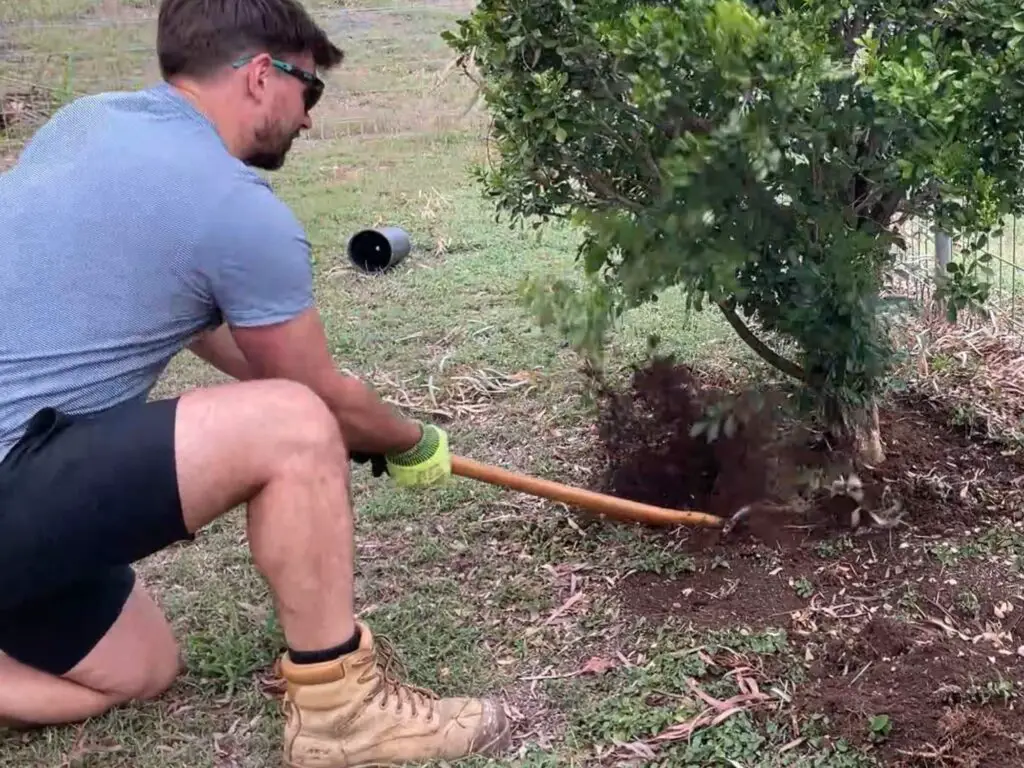
Why Do Axes Need to Be Sharpened
Axe blades can become dull and ineffective over time. A dull axe blade can make cutting very hard, and even make the axe more dangerous as the axe could bounce or skip off the cutting surface, causing injury to the user.
Sharpening an axe will restore its sharpness and cutting effectiveness, which will make it easier and safer to use.
In this guide, I explain how to sharpen an axe with a file. Read this whole guide so you can see the proper technique to sharpen your own axe with a file, and not make any mistakes.
Safety Precautions when Sharpening an Axe
Sharpening an axe can be a dangerous task. Here are some tips that you should at least be aware of.
Wear Personal Protective Equipment
You should wear thick gloves and safety glasses to help protect your hands, wrists, and eyes.
Secure the Axe
Secure your axe during sharpening with either a vice or by clamping it to your workbench. Keeping a steady axe will make sharpening easier, and prevent it from slipping and possibly cutting yourself.
File Away from Yourself
When using a file, position yourself so that you are pushing the file away from your body. Do not position yourself so that the file moves either across your body or towards your body.
This removes the risk of the file slipping and you cutting your hand or arm.
Use the Right File
There are many different types of files. The best type of file to sharpen your axe if it is really dull and has chips or dents that need to be taken out is a double or diamond-cut flat file. If you are just honing your axe edge, a single-cut flat file will be sufficient.
Clean the File
Both before and after using your file to sharpen your axe, clean the file with a wire brush. This will keep it clear of metal shavings that accumulate in its teeth and make it more efficient at sharing and cutting.
How to Choose the Right Type of File to Sharpen an Axe
I have a comprehensive guide on choosing the right type of file to sharpen an axe.
My preferred type of file to sharpen my axe is a course double-cut or diamond-cut flat file. With just this type of file, you will be able to sharpen the bluntest of axes.
If you have a fine single-cut file or a sharpening stone, this can be used for honing an axe blade, and for sharpening when there isn’t much work required.
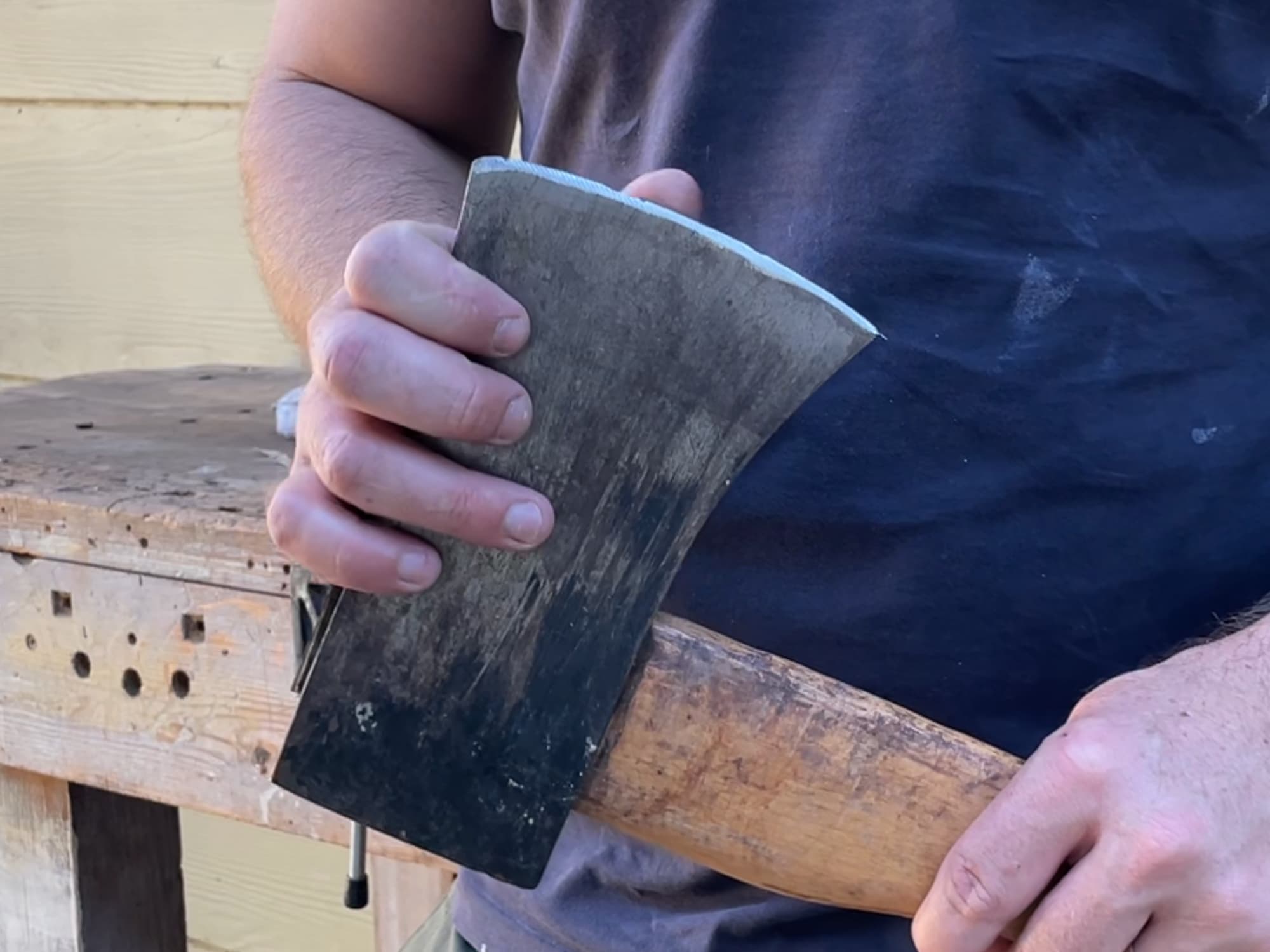
How to Sharpen a Blunt Axe With A File
Prepare Axe Head for Sharpening
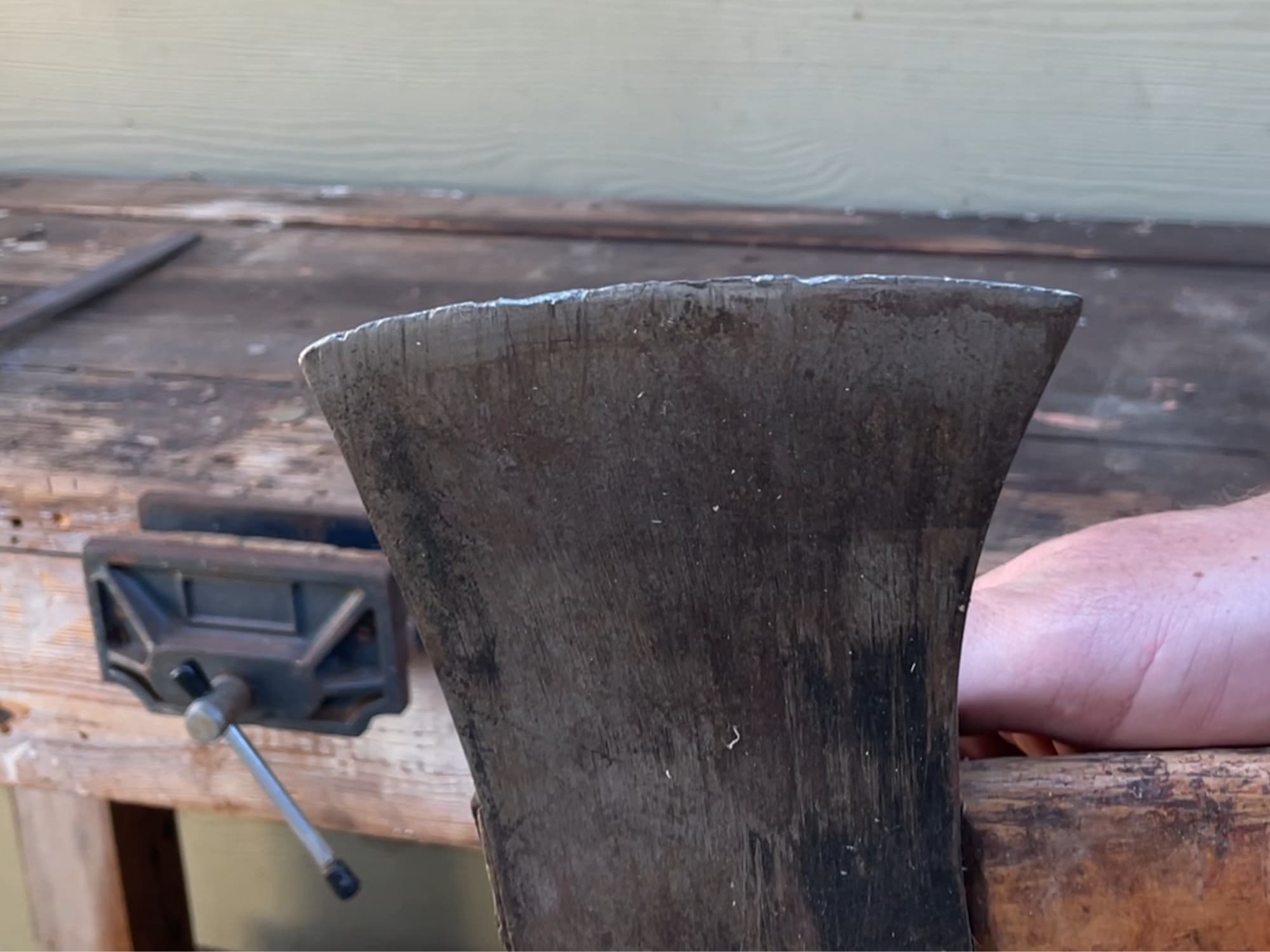
Before sharpening the axe head, it’s best to clean the axe head of any dirt, wood, or anything else that is on the axe head.
You can use just a wet sponge or cloth to do this. Soap is optional depending on how dirty your axe is and how clean you want it to be.
Secure the Axe

Clamp your axe to a workbench with a vice to prevent it from moving during sharpening. This will make sharpening the axe much easier.
Sharpen the Axe
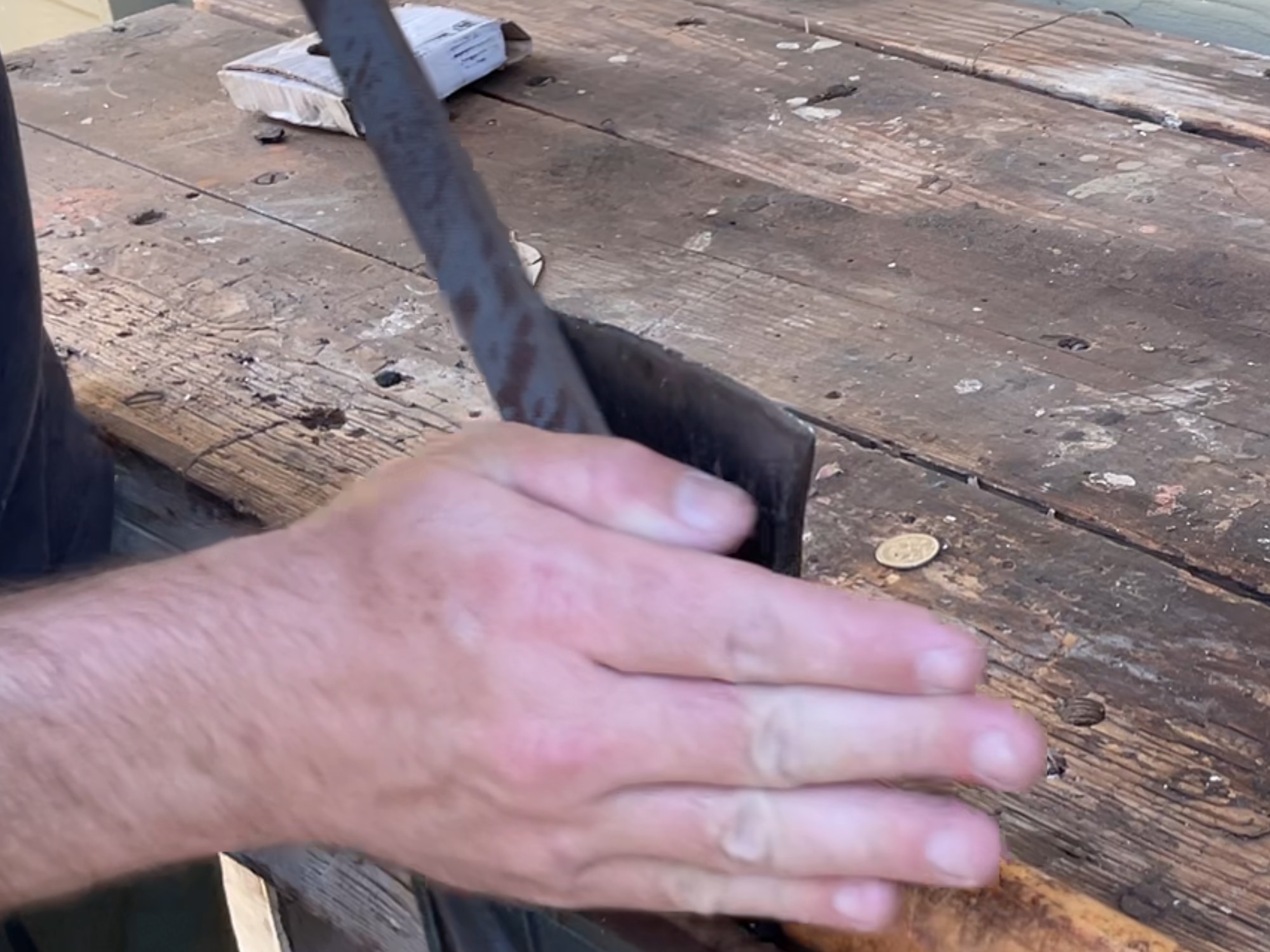
The steps to sharpening an axe with a file are:
1. Position yourself to always push the file away from your body. Never pulling it towards you.
2. Place your file at the start of the axe blade and angle it so it matches the axe’s current bevel (the cutting edge).
3. Push the file away from you while dragging it across the bevel. Do this at a controlled and steady speed, you do not need to make rushed strokes.
4. Keep repeating steps 2 and 3 until the axe reaches the desired sharpness.
The proper safety equipment to wear for this is thick gloves and safety glasses.
Sharpening the Axe (Continued)
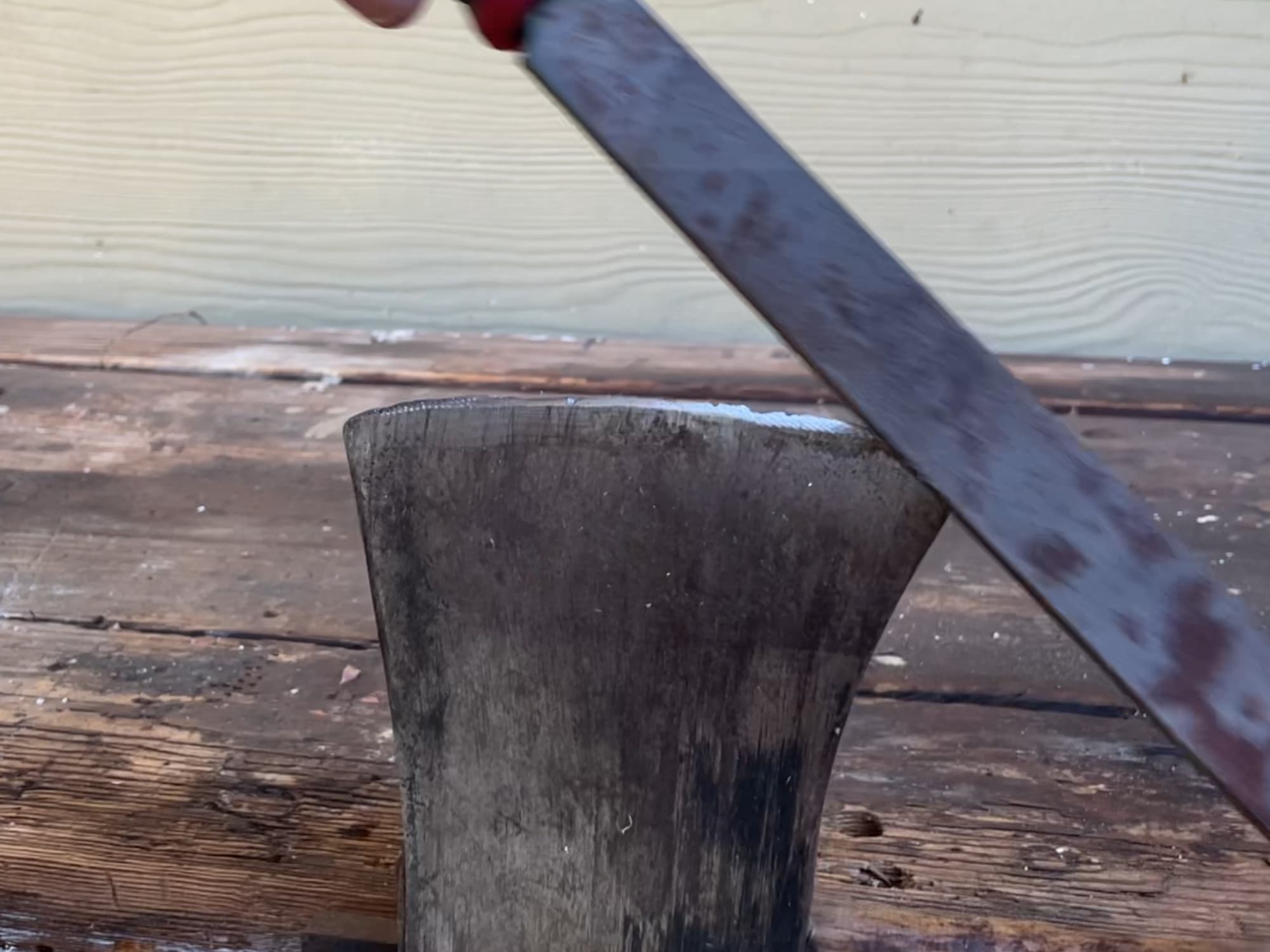
Keep sharpening the axe until its desired sharpness is reached.
You will be able to see the axe head edge become shiny as the metal is removed from the edge.
Sharpen Axe with A Sharpening Stone
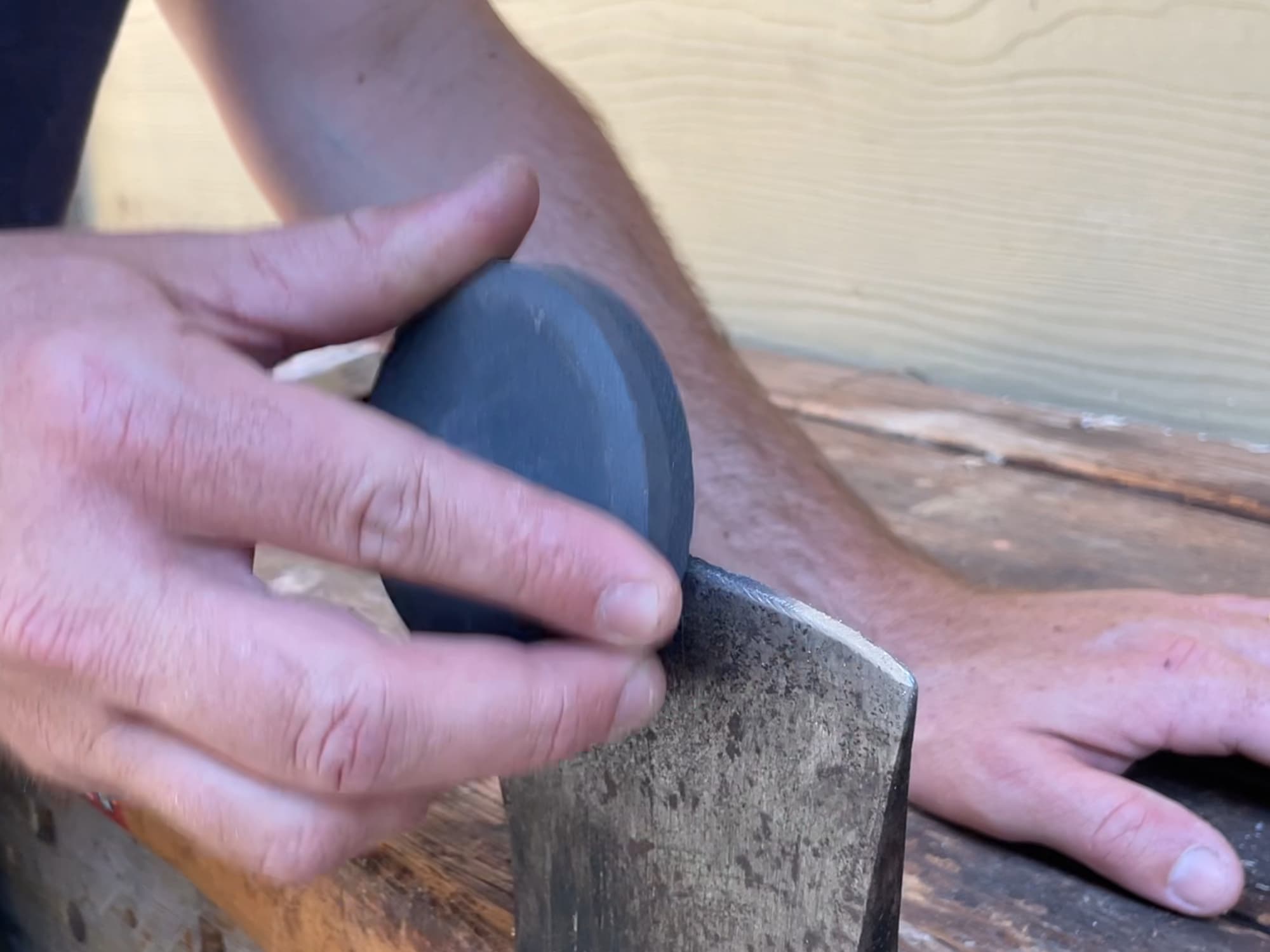
This step is optional for me. If you want the axe blade to be even sharper than what you can achieve with a flat file, you will need to use a sharpening stone.
1. Apply some lubricant to the sharpening stone, either water or oil.
2. Hold the sharpening stone at one end of the axe edge and match the stone to the bevel.
3. Move the stone in a circular motion from one end of the axe to the other, and then back again.
4. You can remove any burrs from the sharpening process by dragging the axe head along a leather belt.
This will really hone your axe so that it will be sharp.
I have the Trojan Pocket Axe Sharpening Stone, but you can use any sharpening stone available from your local hardware store.
Here is a really good video that explains how to use a sharpening stone.
After Care of An Axe Once Sharpened

Once your axe has been sharpened there are a few steps you can take to look after your axe.
Cleaning the axe. Clean the axe of any dirt and metal shavings after sharpening. You can use either a damp cloth, or if very dirty you can use a soapy sponge. Wipe down the axe dry it properly, and apply a light layer of oil to prevent the axe head from rusting.
Protecting the axe edge. To protect the newly sharpened edge of the axe head, place a blade cover or a sheath over the end of it during storage. This will prevent any accidents where the axe head may get damaged.
Tools:
- Axe
- Flat file
- Sharpening stone (optional)
- Vice
Common Mistakes Make when Sharpening an Axe
Using the wrong file type. If you choose the wrong type of file, you could take a lot longer to sharpen your axe. I have a guide on the best type of file to sharpen your axe to help you understand which file is best to use.
Filing in the wrong direction. When sharpening your axe with a file, you always position yourself so that you are pushing the file away from your body. If you are filing and moving the file across your body or towards you and the file slips, there is a chance that you may cut yourself.
Over filing. This is a mistake you can make if you choose the wrong type of file or are not sure of the correct method to sharpen your axe. You do not want to overfile your axe edge as if it is too thin it will be weak and more prone to chipping.
Failing to lubricate the file. Lubricating the file before you start sharpening your axe head helps the file stay clear of any metal shavings or dust and dirt. If your file is clogged with lethal shavings it will not be able to file very well.
Not wearing personal protective equipment. To help prevent you from hurting yourself, it is best to wear the proper personal safety equipment. This includes some thick gloves that cover both your hands and wrists, and some clear safety glasses to protect your eyes from getting metal shavings in them.
Maintaining your axe
Regular sharpening. The key to maintaining a sharp edge on your axe is regular sharpening. A dull axe can make chopping wood harder and more dangerous.
Cleaning. Dirt and debris can accumulate on the axe blade and handle over time, which can cause rust and corrosion. Clean the axe head and handle with a cloth and soap after each use, and dry and store it in a dry place.
Storage. An axe needs to be in a dry place so rust doesn’t form on the axe head. It also should be stored in a sheath to protect the axe edge from accidental damage.
Inspection. Regular inspection will help guide the maintenance of the axe head and handle. If there are any signs of damage or wear and tear, these can be identified and corrected.
What Is the Best Type of File to Use for Sharpening an Axe?
Either a double-cut or diamond-cut flat file is the best type of file to use to sharpen an axe. This is because both of these types of files can remove material more quickly than a single-cut file.
Single-cut flat files are only good for finishing off sharpening an axe as they don’t remove as much material as the other file types.
How Long Does It Take to Sharpen an Axe with A File?
This depends on how blunt your axe is, but a good enough finish can be achieved in as little as 5 minutes with a file. But if you want a good finish, sharpening an axe could take as long as 20 to 30 minutes.
What Is the Proper Angle to Sharpen an Axe with A File?
It is best to match the existing bevel of an axe when sharpening it. This would usually be between 20 to 25 degrees. Keeping the bevel even across the entire axe is an important step in the axe sharpening process.
Can You Sharpen an Axe with Sandpaper?
You can sharpen an axe with sandpaper but it will take a very long time. Also sand paper will wear out quickly.
It is best to use either a file or a sharpening stone to sharpen an axe.
What Is the Difference Between Sharpening an Axe with A File versus A Stone?
A file is a more aggressive way to sharpen an axe and takes off much more metal than a sharpening stone.
A sharpening stone is a more precise method to sharpen an axe that allows more control over the sharpening process.
Both methods as effective ways to sharpen your axe, so choose the one that works best for you.
What Is the Best Technique for Sharpening an Axe with A File?
Always position yourself so that you are pushing the file away from your body. Start with the file at the edge of the axe, match the file angle to the axe bevel, then push away from your body in a smooth action with consistent pressure, push the file from one end of the axe to the other.
You only need to apply light pressure to sharpen an axe. Too much pressure and too much metal can be removed from the axe head, making the axe edge uneven.
Once sharpened with a file, a sharpening stone can be used to hone the edge, remove any burrs and polish the edge.
What Is the Best Grit for Sharpening an Axe?
Most axe-sharpening stones have two grits on each side of the stone. My axe sharpening stone has a 120/280 coarse grit which is good for most axes and applications.
What Is the Difference Between an Axe-Sharpening Stone and An Axe-Sharpening Kit?
An axe sharpening stone is a single sharpening tool that is used to sharpen an axe edge. An axe sharpening kit contains multiple tools including sharpening stones, files, and honing oil.
An axe sharpening kit is for anyone who is regularly sharpening their axe and has multiple axes that need to be sharpened.
What Is an Axe Sharpening Gauge and How Is It Used?
An axe sharpening gauge is a tool that is used to measure the bevel angle of an axe. It can be made of metal or plastic.
